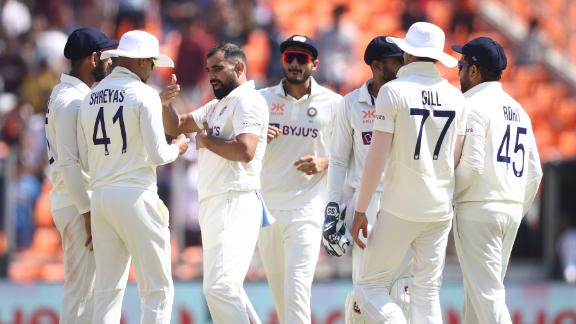India 289 for 3 (Gill 128, Kohli 59*) trail Australia 480 (Khawaja 180, Green 114, Ashwin 6-91) by 191 runs
Second week into the third month, Shubman Gill scored his fifth international century of the year to lead India's response to Australia's 480. For long periods, Australia did well to keep a lid on the scoring rate, but Gill was not to be denied for too long: his 128 off 235 was a contrast to the 152 the others managed off 361 balls between them.
India ended the third day 191 behind with seven wickets in hand. Virat Kohli scored his first fifty since the Cape town Test at the start of last year, and ended the day with the promise of a hundred.
There was a little more turn and misbehaviour available from the pitch, but it was not nearly enough to make survival difficult. So Australia did the next best thing possible: bowl to one side of the pitch and wait for mistakes. The batters discovered that while there might not have been great threat to their wicket, scoring wasn't the easiest either.
This Test has been the opposite of the other three in many ways. One of them was a return to the old Indian trend of batting being easier against the new ball. India's early assault on Mitchell Starc meant the first 15 overs of three of the four new balls used in this match had gone for 193 runs and no wicket. Perplexingly, Starc bowled predominantly around the wicket, failing to create rough for his two offspinners.
Once Australia went to spin at both ends, the runs dried up, and a loose stroke arrived. Rohit Sharma punched an innocuous-looking delivery from Matt Kuhnemann straight to short extra cover. The six overs leading up to the wicket had brought just 10 runs.
The start to the partnership between Gill and Cheteshwar Pujara wasn't quite swift, but once Australia went back to pace, the tap opened again. The second ball of Starc's new spell was cover-driven to bring up Gill's fifty. In Starc's next, Gill played the short-arm punch through midwicket for four more. Leading up to lunch, Pujara, too, got a move on.
Although a couple of deliveries had disturbed the surface in the first session, there wasn't anything dramatic. Australia came back with more focused plans. It often involved seven-two leg-side fields with everything turning in. After the two initial boundaries off Cameron Green, India spent 16 overs in the middle session without a boundary.
Having played in India before, having played against Pujara and the others, he knows how they play, says Wasim Jaffer
All through the period, though, neither Pujara nor Gill looked at any discomfort. Eventually pace provided Gill an opening. He marked it with two lovely cover drives off Green: on the up first, and then to the fuller ball. In his 90s, Gill danced down to Lyon to pop him over his head, and then played the sweep over leg slip to bring up his second Test century.
Just before tea, Pujara, too, seemed to make an unforced error, playing down the wrong line of a Todd Murphy offbreak from around the wicket. Even as Pujara reviewed the lbw decision in vain, the crowd cheered on for the arrival of Kohli. In the one over before tea, Kohli edged one wide of short leg, one short of slip and was beaten on the outside edge once.
After tea, Gill and Kohli were much more efficient, running hard, not taking any risks. As Gill began to cramp, Kohli took up his scoring, contributing 32 to the 58-run stand. Having made just nine false responses in such a long innings, Gill finally made the fatal error: going back to a quick full offbreak from Nathan Lyon, getting trapped right in front.
If there was any designs on dominating the bowling, India shelved those plans and batted sedately. The new ball was eight balls away, but Australia waited for the last 20 minutes to claim it.
The offspinners kept trying to test both edges of Kohli as he lunged forward in defence, but the one time that the inside edge was taken, they didn't have a short leg in place, which can happen when bowling at 250 for 3. Other than the odd half error, Kohli looked in absolute control.
The one thing Australia managed by continuing with the old ball was the run-rate. Just 26 came in the first 15.2 overs of the fourth-wicket stand between Kohli and Ravindra Jadeja. As soon as the new ball was taken, Jadeja hit a six off Kuhnemann having been 6 off 42.
Largely, though, the final exchanges remained a period of cease fire from both sides. Australia had few catchers, India took fewer risks. With only 13 wickets falling in three days, the Test was left needing something dramatic for an outright result.




